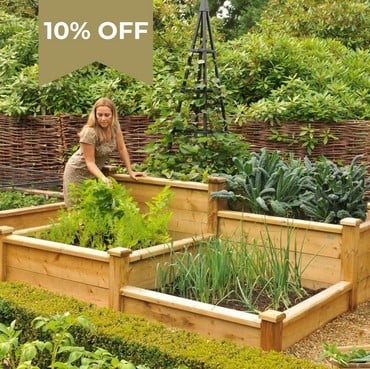Our quality Raised Bed Liners have been carefully designed to fit our range of Allotment Wooden Raised Beds & Standard Wooden Raised Beds with various sizes and depths to provide added protection if the beds are on hardstanding areas and also to help water retention and prevent soil washing out of the raised beds.
We'd thoroughly recommend you use one of our thick, one piece, polypropylene fabric raised bed liners when growing in raised beds on the patio; the porous material of the liner will help water retention, prevent the compost and soil from running out onto the hard surface - possibly causing staining - and will also help prevent weeds from growing through from beneath, a further reason for using a liner if your bed is positioned on soil or turf.
Our raised bed liners come in a wide range of different dimensions. The raised bed liners will fit one, two and three tier versions of the Allotment and Standard beds (15cm, 30cm and 45cm).
- Raised Bed Liners manufactured from polypropylene fabric
- Will fit single, double and triple tier versions of Allotment and Standard Wooden Raised Beds
- Liners help to regulate drainage and retain water
- Please Note: liners are no longer supplied with corner loops
- Raised bed soil is notorious for drying out
- Liner will retain fine sand and compost used when growing certain vegetables e.g. carrots
- Ideal if the bed is located on a patio, in a courtyard or even on tarmac
- Helps prevent leaching of soil and nutrients
- Threat of staining patio or other hardstanding area is reduced
- Liner helps suppress weed and grass growth when bed is positioned on soil or turf
- The Raised Bed Liners are available to fit beds of the following sizes (actual liner dimensions will be smaller):-
- 0.6m x 0.6m (2ft x 2ft)
- 0.6m x 1.2m (2ft x 4ft)
- 0.6m x 1.8m (2ft x 6ft)
- 0.6m x 2.4m (2ft x 8ft)
- 1.2m x 1.2m (4ft x 4ft)
- 1.2m x 1.8m (4ft x 6ft)
- 1.2m x 2.4m (4ft x 8ft)
- 1.8m x 2.4m (6ft x 8ft)
Please Note: On occasion if a certain size liner is unavailable we may substitute for a liner made from a weed control material. This offers the same properties as the woven liner and will serve the same job, it just means customers do not have a delay between receiving their beds and liners which may delay installation.
Product Reviews
From customer service, delivery and ease of putting them together absolutely brilliant!
Excellent product as description stated. Easy to construct and they look good. Too soon to rate performance as nothing planted as yet. A fiar price for a quality product.
Product Videos
RAISED BED LINER FREQUENTLY ASKED QUESTIONS
1. Are weeds suppressed?
If the bed is positioned over ground with persistent weeds they may push through so we recommend using a liner to help prevent this and weeding beforehand.
Weeds are suppressed more when growing in raised beds as the crops can be planted closer together due to the fertile well aerated soil. This is more likely to starve the weeds of light and nutrients.
Also the lighter, un-trampled condition of the soil makes weeding a doddle.
2. Do raised beds require more watering?
It very much depends on what you are comparing them to and what substrate they are sitting on.
If you have very sandy soil in your garden and you switch to raised bed gardening, you can select a soil for the raised beds that is better at retaining water, coupled with a liner this will help reduce water loss.
Raised beds will warm up faster than a traditional bed so you do need to keep an eye on how dry the soil is.
If the soil under the bed is heavy clay and water logged, obviously drainage may be a problem. A few inches of gravel in the base of the bed will help in this situation.
3. How much soil do I need to fill my bed?
Multiply the depth cm x width cm x length cm = (result) ÷1000 = amount in Litres
e.g. for a 4ft x4ft x 1 tier bed: 120cm x 120cm x 15cm = (216,000) ÷ 1000 = 216 Litres
1000 Litres = 1m3 = 35.3 ft³
4. Do you need to put anything in the raised bed to help with drainage?
This depends on where the raised bed will be situated in the garden. If the raised bed is being placed directly onto soil the drainage should not be a problem because the excess water will drain through the grass/soil underneath it.
If the soil is heavy clay and water logged obviously drainage may still be a problem. A few inches of gravel in the base of the bed will help in this situation.
On free draining soil a liner may help conserve water as it will prevent the water draining too fast. consider the type of soil/compost that you are going to fill the bed with and tailor it to suit the site.
If the raised bed is being placed onto a patio, we recommend lining the inside of the bed, this will help retain water and also prevent fine sand from washing out of the bed onto the patio.
What The Press Say
Grow Your OwnJanuary 2014
Raised Beds and Planter On Test - Dave Finkle
5 ***** At first I thought, here we go again - another load of liner that needs stapling into place with a few untidy folds. But as I unfolded the material I was struck by how thick and durable it was. I was most impressed by the fact that it was tailor-made to fit the raised bed perfectly. It even had loops in the four corners for the Slot & Lock frame.
View All Options & Prices




























